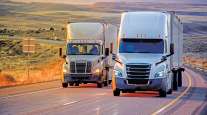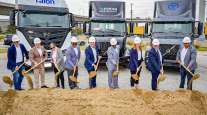Los Angeles Daily News
Twin California Ports Introduce Zero-Emission Locomotive

[Stay on top of transportation news: Get TTNews in your inbox.]
Weeks after the California Air Resources Board approved an ambitious rule to limit rail pollution, the Pacific Harbor Line on May 4 unveiled one of the nation’s most advanced zero-emission locomotives — which will be tested for the next year on shorthaul routes in the ports of Los Angeles and Long Beach.
The new zero-emission, zero-idle EMD Joule battery electric locomotive, a product of Caterpillar subsidiary Progress Rail, will serve Pacific Harbor Line’s cargo shorthaul service between ships and terminals, joining low-emissions diesel locomotives also serving in the ports.
The May 4 event at a rail yard in Wilmington, Calif., also marked the graduation of eight locomotive engineers.
The featured speaker, Federal Railroad Administrator Amit Bose, pledged that the federal government would continue to provide support to both ports as they push forward to become zero-emissions operations.
“To have the best rail service and ports in the world,” he said, “we need to invest in both modern infrastructure and the workers who keep operations moving.”
Trains have long been an important part of California’s legacy. It is, after all, where the West Coast tracks for what became the first transcontinental rail service originated, Bose said, turning the state from an isolated agrarian outpost to the economic hub it is now.
When Otis Cliatt, president of Pacific Harbor Line, took the stage, he pointed out that there was no sound coming from the green-and-white locomotive behind him.
“This locomotive right now is actually operating,” he said as the crowd applauded. “It’s on.”
The newest class of locomotives will join PHL’s short line service in the ports. PHL likes to say “we make Christmas happen,” Cliatt said, referring to the major impacts rail has on getting cargo from the ports to every state across the nation, including during the challenges of the COVID-19 pandemic.

This special "Inside the List" episode features the Transport Topics 2023 Top 100 largest logistics companies. Hear the program above and at RoadSigns.TTNews.com.
The company, he said, is also “referred to as the ports’ railroad.”
Both port executive directors were on hand during the event and spoke about the zero-emissions challenges that lie ahead. As cargo handling equipment and trucks begin to test out clean technology, said Port of Long Beach Executive Director Mario Cordero, “locomotives were a little more challenging.”
“This will be a game-changer,” he said of the new locomotives, calling them “the shape of things to come.”
Port of Los Angeles Executive Director Gene Seroka, meanwhile, said bridging technologies as the ports strive to meet clean standards is on a fast-track.
But the ports also need to stay competitive, he said. The L.A.-Long Beach gateway is big enough to push forward with the new technology and environmental standards, which also come with more regulations. But the ports, Seroka said, need to work “hand in hand with business.”
“We can do all of this,” Seroka said of the challenge.
Rail is seen as a way to cut truck congestion and pollution, and both ports are moving toward using more on-dock rail connections to move cargo out. CARB moved, in late April, to limit rail pollution focuses on substantially cutting greenhouse gas emissions from locomotives.
The standards, however, still need approval from the Biden administration to move forward.
Locomotives running on diesel pull rail cars long distances, producing pollution for those who live nearby and contributing to greenhouse gases. The rule would ban locomotive engines more than 23 years old by 2030 and increase the use of zero-emission technology to transport freight from ports and throughout railyards.
Want more news? Listen to today's daily briefing below or go here for more info:
Distributed by Tribune Content Agency, LLC




